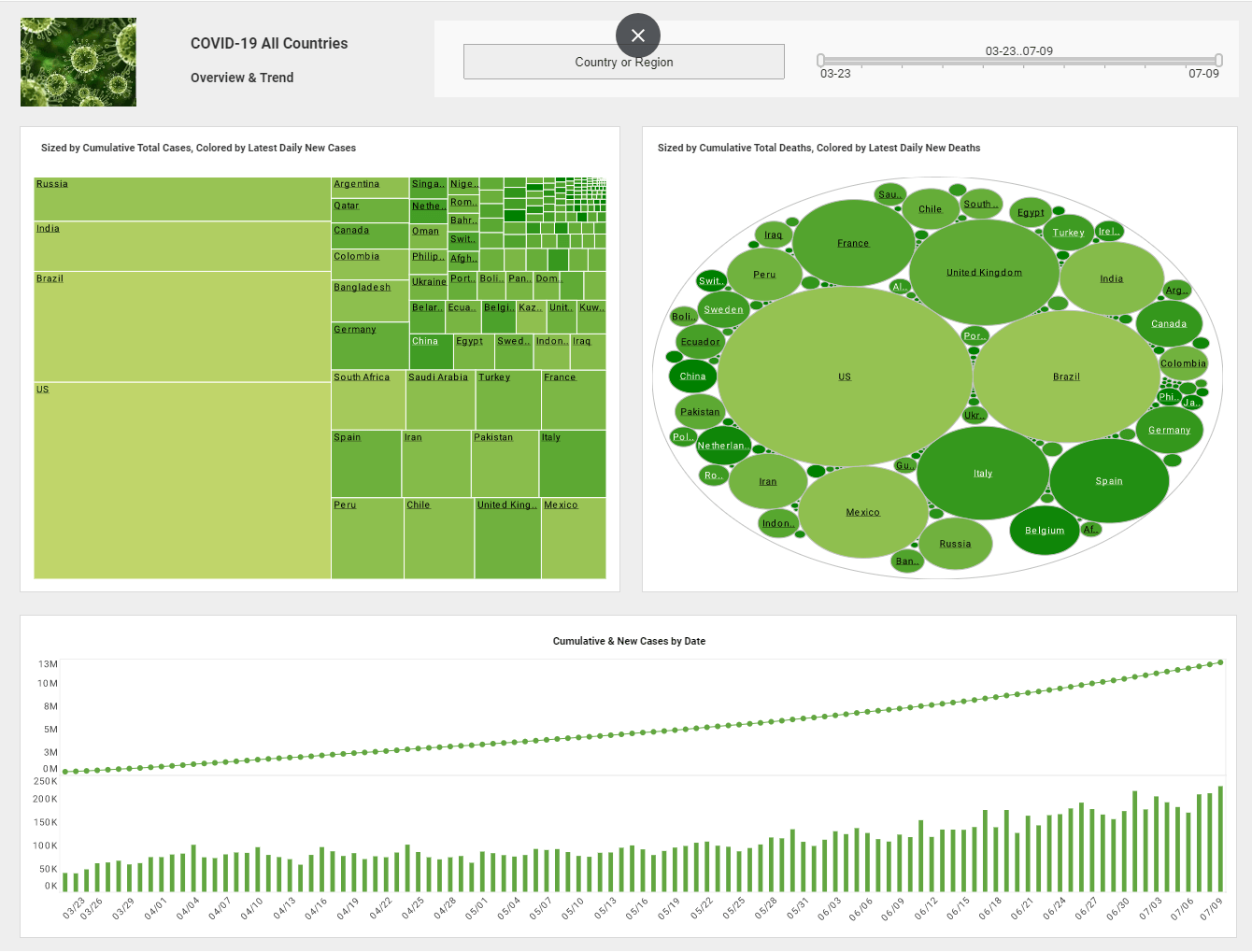What Are Some More Drivers of Self-Service BI?
This is a continuation of the transcript of a Webinar hosted by InetSoft entitled "Why Self-Service BI?" The speaker is Mark Flaherty, CMO at InetSoft.
Mark Flaherty (MF): When it comes to business reporting requirements, most of the time business users spend a lot of time explaining what they need to do to the IT teams. After they get the report they spend more time realizing they needed to filter it a certain way, and have to go back and modify the request.
The reason for this inefficient cycle is the wrong choice in information management technologies. It must have limitations in terms of the data structure in the data warehouse and in terms of the front end, limitations in formatting capabilities, due to the lack of availability of standard formatted reports and the difficulty of creating ad hoc reports.
Business users are heavily dependent on IT in this traditional scenario. With all this difficulty in the daily access of information in the existing BI environment, business users have tended to avoid using the BI tools.
The absence of self-service BI, therefore, results in business people make fewer decisions based on fact, or they miss key facts that could be found in the data. This, in turn, results in riskier business performance, if not poorer results in the bottom line.
| #1 Ranking: Read how InetSoft was rated #1 for user adoption in G2's user survey-based index | Read More |
Need for Self-service BI
So today many enterprises have become aware of the need for self-service BI, and placed it on their priority list, before the alarm bells start ringing. It is very critical for organizations to look at the existing internal BI architecture which has been developed over a period of time without a cohesive long-term strategy.
Organizations need to assess the existing BI environment and develop a new long-term strategy which will lead to a greater independence on IT for access required data. Based on this strategy a roadmap should be laid out to achieve a self-service BI environment which will make their business agile, adaptable, and efficient. We definitely see focus on strategy as being the key overriding factor for business intelligence now, where before it was very tactical.
The successful approach to self-service reporting is based on developing an information delivery layer that puts data in the hands of end-users. The end-state vision should be such that business users can quickly view the key performance indicators at both the strategic and tactical levels. Balanced scorecards and drill-down capability to the operational level to understand the drivers of business performance are typical deliverables.
Case Study of a Scrap Metal Recycling Firm Leveraging Self-Service BI for Operational Efficiency
GreenCycle Metals is a mid-sized scrap metal recycling firm that specializes in processing and recycling ferrous and non-ferrous metals from a variety of sources, including industrial scrap, decommissioned vehicles, and demolition waste. With operations spread across multiple facilities, the firm faced the challenge of managing a large amount of data related to inventory, operational efficiency, market pricing, and compliance.
Previously, GreenCycle relied heavily on manual data analysis using spreadsheets, which limited its ability to act on real-time insights. Decision-making was often reactive, causing inefficiencies in scrap processing, transportation logistics, and pricing strategies. To remain competitive in the ever-evolving recycling industry and optimize its operations, GreenCycle implemented a self-service BI (Business Intelligence) solution to empower staff with real-time insights and improve overall operational efficiency.
Challenges Faced by GreenCycle Metals
Before adopting a self-service BI tool, GreenCycle Metals encountered several key challenges:
-
Disparate Data Sources: GreenCycle's data was siloed across various platforms, including ERP (Enterprise Resource Planning) systems, inventory management software, and spreadsheets. This made it difficult for decision-makers to get a comprehensive view of operations, inventory, and revenue generation.
-
Manual Reporting: The reliance on manual reporting using spreadsheets was time-consuming and prone to errors. Operations managers had to spend hours compiling reports, which delayed decision-making and often led to outdated information being used to make critical decisions.
-
Inconsistent Pricing Strategies: The recycling industry is highly sensitive to fluctuations in global metal prices. GreenCycle struggled to keep track of market trends and frequently failed to adjust its buying and selling prices in real-time, which negatively impacted profitability.
-
Operational Inefficiencies: Tracking the performance of different recycling facilities, equipment utilization, and transportation logistics was difficult. Without a unified dashboard, management lacked visibility into bottlenecks in processing or transportation that were causing delays and higher operational costs.
-
Compliance and Sustainability Metrics: Increasing environmental regulations required GreenCycle to closely monitor and report on its compliance with emissions, waste management, and recycling efficiency standards. However, collecting and analyzing this data across different departments was cumbersome.
Solution: Self-Service BI Implementation
GreenCycle Metals decided to implement a self-service BI solution to address its data management and reporting challenges. The company chose a platform that allowed employees at all levels to access, analyze, and visualize data without relying on the IT department. This democratized access to information, enabling managers and decision-makers to pull insights and build reports independently.
Key Features of the Self-Service BI Tool
-
Centralized Data Integration:
- The BI tool integrated data from GreenCycle's ERP system, inventory management software, CRM (Customer Relationship Management), and external market data sources, creating a centralized data hub. This allowed the company to consolidate and view data in real-time across all operations.
-
Customizable Dashboards:
- Managers across departments (operations, finance, sales) could create their own customized dashboards tailored to their specific needs. For instance, operations managers focused on facility efficiency and scrap processing rates, while the sales team tracked metal prices and customer demand.
-
Real-Time Data Analytics:
- The self-service BI platform provided real-time analytics on critical KPIs (Key Performance Indicators) such as metal throughput, inventory levels, facility performance, and market price fluctuations. This allowed decision-makers to act quickly based on current data rather than relying on static reports.
-
Predictive Analytics:
- The tool also integrated predictive analytics features, allowing GreenCycle to forecast metal price trends and adjust their buying/selling strategies accordingly. This helped the firm stay ahead of market volatility.
-
Automated Reporting:
- The BI platform automated many of the company's reporting needs, allowing managers to schedule reports on a daily, weekly, or monthly basis. These reports could be distributed to stakeholders automatically, saving time and reducing the burden on the IT department.
-
Mobile Access:
- The self-service BI tool had mobile access capabilities, allowing managers to check dashboards and KPIs on-the-go. This was especially useful for employees overseeing multiple recycling facilities or traveling to meet clients.
Implementation Process
The implementation of the self-service BI platform at GreenCycle Metals was phased and strategic to ensure smooth adoption across the company.
1. Data Integration and Cleaning
- The first step involved integrating all relevant data sources into the BI platform, ensuring that data was clean, accurate, and up to date. The IT department worked closely with the BI provider to ensure seamless integration of data from legacy systems and external data sources, such as metal market price indices.
2. Training and Empowerment
- GreenCycle invested in comprehensive training for its employees. Department managers and staff were trained on how to use the self-service BI tool to create their own reports, customize dashboards, and analyze data. This reduced reliance on the IT team and allowed employees to gain confidence in making data-driven decisions.
3. Custom Dashboard Creation
- Each department was responsible for creating custom dashboards suited to its needs. Operations teams created dashboards that tracked scrap processing rates, equipment utilization, and facility efficiency, while the sales department focused on dashboards monitoring customer demand, metal prices, and sales forecasts.
4. Ongoing Support and Optimization
- After the initial implementation, GreenCycle worked closely with the BI provider to continuously refine and optimize the platform based on user feedback. Regular updates and new features were rolled out to enhance the tool's functionality.
Results and Impact
The implementation of the self-service BI tool led to significant improvements across various areas of GreenCycle's operations.
1. Operational Efficiency Gains
- By having real-time visibility into the performance of different recycling facilities, GreenCycle was able to identify bottlenecks in the processing of metals and optimize equipment usage. For example, one facility had consistently lower throughput than others, which was quickly identified through the BI dashboards. GreenCycle addressed this by reallocating resources, leading to a 20% improvement in processing efficiency.
2. Improved Pricing Strategy
- The ability to track metal market price trends in real time allowed GreenCycle to adjust its pricing strategies more effectively. The company could buy scrap at lower prices when global metal prices were falling and sell processed materials at higher margins when prices spiked. This resulted in a 15% increase in profit margins in the first year after implementation.
3. Faster and More Accurate Decision-Making
- With access to real-time data, department managers no longer had to wait for weekly reports to make decisions. Instead, they could quickly pull insights from the BI tool to inform their decisions on the spot. This accelerated decision-making processes and helped the company be more agile in responding to market changes.
4. Enhanced Compliance and Sustainability Reporting
- GreenCycle was able to streamline its compliance reporting by automatically generating reports on emissions, recycling rates, and waste management metrics. This not only saved time but also ensured that the company met all regulatory requirements without any lapses, protecting it from potential fines or sanctions.
5. Cost Reductions in Logistics
- By analyzing transportation routes and scrap collection times, GreenCycle optimized its logistics operations. The BI tool highlighted inefficiencies in transport schedules and unnecessary delays, allowing the company to cut down fuel costs by 10% and reduce overall transportation times.
6. Employee Empowerment and Data Literacy
- Employees across departments felt more empowered to make data-driven decisions. The availability of user-friendly dashboards meant that non-technical staff could independently create reports and visualize data without needing IT assistance, fostering a culture of data literacy and ownership.
| Previous: What is Self-Service BI? |


